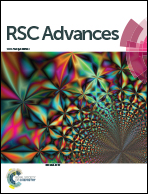Novel composite membranes based on sulfonated poly(ether ether ketone) and adenosine triphosphate for enhanced proton conduction
Abstract
Adenosine triphosphate (ATP) molecules, which contain proton-conductive phosphoric acid groups, imidazole groups and amino groups are incorporated into sulfonated poly(ether ether ketone) (SPEEK) to fabricate novel composite membranes. The morphology, structure and proton conduction abilities of the prepared membranes are investigated. ATP coalesces with SPEEK through ionic interactions between amino groups and sulfonic acid groups, which are beneficial to the stable existence of ATP molecules within polymer networks and enhance the thermal stability of the composite membranes. Due to the formation of abundant acid–base pairs among ATP molecules as well as between ATP and SPEEK chains, the proton conductivities of composite membranes under different conditions are increased in comparison with the plain SPEEK membrane, and this improvement becomes more evident when humidity is decreased. Particularly, the SPEEK/ATP composite membrane displays a highest proton conductivity of 0.198 S cm−1 at 80 °C and 100% RH. The proton conductivity of the SPEEK/ATP-20 membrane at 41% RH is nearly 30 times higher than that of the plain SPEEK membrane. The results indicate a promising potential of such acid–base pairs which contain –PO3H2 groups in enhancing the proton conduction of membrane materials.


 Please wait while we load your content...
Please wait while we load your content...